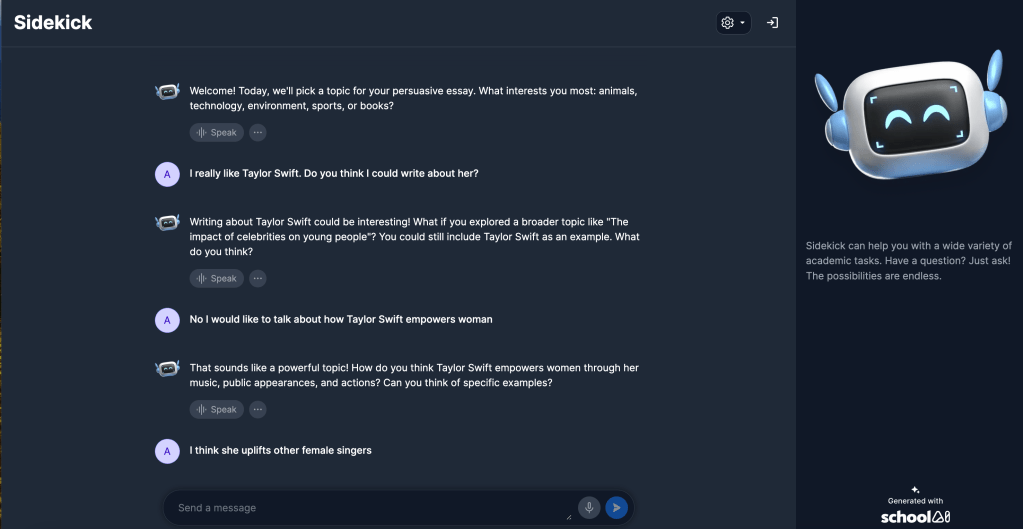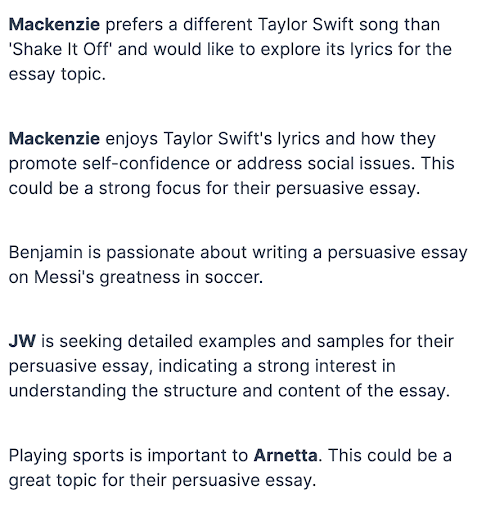Helping Students Use AI Creatively Without the Temptation of Cheating
Designing school-friendly chatbots with firm guardrails can spur students toward creative AI use that doesn’t do their work for them.
When ChatGPT was introduced to the public in late 2022, it sparked a significant divide in the education community. On one side, teachers recognized the potential of this tool as a means of personalizing and democratizing learning. On the other, some educators expressed concerns that it would become an ultimate cheating tool, leading to a decline in authentic and creative thought.
In the last year, I have worked hard to take a less dichotomous view of artificial intelligence (AI) in the classroom and have looked for ways that AI might support and foster personalized learning and help educators rethink AI as just a “cheating tool.” Finding that middle ground was made easier when I was introduced to customized chatbots for the classroom, designed specifically for student use. It didn’t take long to recognize that these bots have the potential to introduce a whole new dimension of assistance for students who may be stuck or struggling. After all, we know that students may resort to cheating when they don’t know how to get started or what to do next.
So how do we find this middle ground? It starts with rethinking AI—seeing it less as a threat to critical thinking and objective truth, and more for its potential as a supportive resource to help students produce better, more meaningful work.
Support System
From the outside, interacting with a custom chatbot looks a lot like having a conversation with ChatGPT or any chat-based AI tool, but with some important differences. Teachers who create them using tools like SchoolAI and Mizou can build in firm guardrails to safely support each student, while keeping them focused. Both tools offer students access to customized AI assistants without jeopardizing their data. What sets them even further apart from other chatbots lies in the teacher’s ability to see students’ detailed interactions.
Teachers can precisely control what the student can or cannot do while using them, making it easier to keep students focused on a specific task. It’s important to note that bots do not replace teachers, but instead offer additional assistance to students in a timely manner, helping them get started or progress effectively on their own. At any given time during the writing and brainstorming process, some students might be using AI while others are working independently.
Goodbye, Blank Page
To see how this works, let’s head into a busy middle school language arts classroom where a diverse group of learners are tasked with writing a persuasive essay. The teacher wants to let the students have “voice and choice” in picking their subject and getting started, but as we know, each student needs a different support to help get them on the right track initially. Before the lesson today, the teacher and I set up a chatbot as a student assistant to help personalize the learning experience for each student.
When we sat down to create this chatbot, the teacher explained that one of her biggest frustrations was not being able to devote as much time to helping every student as she’d like. Invariably, during independent writing time, part of the class was often left staring at a blank page, getting little accomplished, while they waited for her to check in with them directly. To help solve this age-old problem, we created a customized bot using SchoolAI to help students start the writing process on their own. We opened up the AI assistant, called Sidekick, and input our guardrails, prompting it to help students pick a topic, get started with research, and uncover some of the angles of their persuasive essay.

Afterward, I point out that she can use the information provided in the teacher dashboard to better understand where each student is in the process, even seeing their conversations with the chatbot itself. This way she can deliver a more tailored experience as more of a writing coach, to each student as needed.
As I look around, the students begin quickly interacting with the chatbot, and the engagement is palpable. We hear comments like “Oh, this is so cool” and “Where has this been all my life?” and “This is helping me so much!” Another student approaches me to say, “Thank you for this. I always needed this help but didn’t want to ask.”
The teacher, who was slightly skeptical at first, is now bouncing around the classroom from student to student, and I can see in her eyes that she has become a convert to using AI in the classroom. The students are diligently working with the help of the chatbot, and each is moving through the task of choosing an idea that they are passionate about, diving deeper into possible topic nuances, while others are getting advice on research, and still others are digging into possible counterarguments.

On the teacher dashboard, we begin to get a summary of what is happening with the student interactions and their individual progress.
At no time during this process will the chatbot write the essay for them, as it was initially created with specific guardrails to make sure this doesn’t happen. This experience was crafted to provide just the right amount of personalized support, so that students can stay on task and not fall behind. Think of this experience as the chatbot being there to get a student unstuck. And while it was helpful for all students, it proved especially valuable for those with dyslexia and English language learners.
Over in another classroom, students in kindergarten are using a customized chatbot to come up with sentences for sight words, and after hearing many different examples, they pick their favorite to share with their partner. In this scenario, the student eventually writes this favorite sentence, full of new and interesting words, into their notebook.
Both of these classrooms of students will grow up knowing that chatbots can help them in more powerful ways than simply cheating or writing an essay for them. They will inherently understand how it is you communicate with AI to get lots of different information, to seek additional help, and to move past not knowing what to do next. These students aren’t left to the Wild West of AI at home with virtually no guidance. This is a huge win for education.
A More Productive Future
We know students need support not only to develop their autonomy and agency in learning but also to achieve specific learning goals. Sadly, students who struggle to grasp concepts at the exact time they are presented in class or fail to get started on time often fall behind, which leaves them frustrated and with learning gaps as the class moves on without them. When this happens, learning gaps begin to accumulate over time and can lead to learning difficulties that shouldn’t exist. This could be massively impacted with just a little targeted and timely assistance.
While still in the beginning stages, these tools offer a glimpse into a future where teachers and AI collaborate to unlock each student’s full potential. The more we work with these tools and the more powerful they get, the more helpful they will be for learners.
